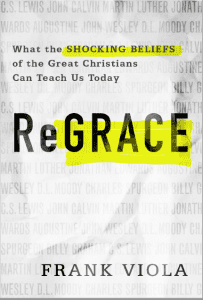 Samaa Habib’s spiritual autobiography—Face to Face with Jesus: A Former Muslim’s Extraordinary Journey to Heaven and Encounter with the God of Love—will probably make you uncomfortable. It will probably make you uncomfortable because on page after page you will be confronted head-on with the fact that what it means to be a Christian in parts of the Middle East, especially to be a Christian born to a Muslim family, is so profoundly dangerous—so fraught with daily threats and risk to one’s physical body not to mention the dangers one’s faith raises for one’s family and friends—that anything resembling “persecution” we are likely to see in America just doesn’t begin to compare.
Samaa Habib’s spiritual autobiography—Face to Face with Jesus: A Former Muslim’s Extraordinary Journey to Heaven and Encounter with the God of Love—will probably make you uncomfortable. It will probably make you uncomfortable because on page after page you will be confronted head-on with the fact that what it means to be a Christian in parts of the Middle East, especially to be a Christian born to a Muslim family, is so profoundly dangerous—so fraught with daily threats and risk to one’s physical body not to mention the dangers one’s faith raises for one’s family and friends—that anything resembling “persecution” we are likely to see in America just doesn’t begin to compare.
Scrolling through my Google alert update on “American Christianity,” which tips me off to new stories about prayer limitations in our public schools, Ten Commandment placards being removed from court houses, and Phil Robertson being asked to tone down his religious rhetoric, has frustrated and saddened me in the past, but these or similar affronts to Christianity in the Western world have never had me literally pushing aside my breakfast in disgust at the abuses like those done to the teenage Habib for openly practicing her faith. Though Habib does not specify her country of origin, we are told that at the time she became a Christian, a vicious religious civil war between Sunni and Shia Muslims was raging, and the lack of law enforcement left city streets open to the free reign of thieves and rapists. Habib describes close calls with both types of thugs on her way to and from church meetings, and her daily life was full of violence. Just to exist, much less to practice a religion of the “infidels” was dangerous: her beloved math teacher is murdered, a school friend is raped, and her mother and sister are shot at by snipers. Beyond external threats though, Habib also suffers at home at the hands of her brother Musa, who takes up for the honor of the family and regularly beats Habib for bringing disgrace to their name. Most horrifically of all though is the bombing of Habib’s church by Muslim jihadists. The bomb—which devastated the church building and took dozens of lives, including the life of a Christian standing directly next to Habib, leaves her hospitalized for many weeks: she goes temporarily blind, and much of her skin is burned off. In the hospital, she is maltreated as well, the doctors and nurses believing her injuries are what she deserves for her infidelity to Islam. This type of suffering for one’s faith is unheard of in America. To read Habib’s story and acknowledge that this type of abuse takes place and, in fact, characterizes the daily lives of Christians across the globe is shocking and unsettling.
Habib’s story will make you uncomfortable as well because of her incredible response to her circumstances. One might imagine that in the midst of such persecution, Habib might be tempted to hide her faith or desire to flee the country as soon as possible. Instead, though, she attributes the Holy Spirit with giving her the supernatural strength to respond to all trials with grace and power in all circumstances. Her nearly reflexive instinct to turn to God for help in moments of trial is inspiring, and the results are stunning. When she is attacked in the streets, prayer gives her the physical strength to use her tae kwon do skills to fend off adult male attackers. Her faith also gives her the strength to boldly proclaim the Gospel message to Muslim men and women across her country without fear. The experiences she has seem more like the Book of Acts than anything I’ve encountered in my 18 years as a Christian or witnessed in the American Christian church. Habib receives visions and prophesies, has extended conversations with Jesus that she records in detail, experiences heaven during a near-death moment in the bomb blast, prays in tongues, and observes miracles and healings happen regularly. She’s not alone in her faith experiences either. She describes dozens of other Christians living under this persecution who experience similar happenings throughout the book. The faith they exemplify and their devotion to Jesus are incredible: at one point, Habib mentions attending a worship service that lasted from 10PM one night to 5AM the next morning. What a far cry from the strictly-timed church services many Americans are used to! In addition, I was struck by how—having not been raised going to Sunday school or in a culture where Christian beliefs and values are widely known—God reveals to Habib complex theological concepts through revelation rather than extended formal training. From the moment of her salvation on, she is able to absorb, memorize, understand, and apply Scripture with phenomenal ease. For every trial, a verse comes to her mind, and she is able to embrace the teachings with such simplicity and let them impact her behavior in life without the least resistance or doubt. A faith that solid and strong is truly rare and exceedingly motivational.
Beyond inspiring individual Christians to rethink what it means to suffer for Christ or to be willing to give up everything for one’s faith though, Habib’s story will also undoubtedly be of interest for evangelists to the Middle East. We see, for example, the powerful influence of bridge evangelism strategies: Habib comes to Christ via a martial arts ministry that offers free classes where students learn tae kwon do and also are exposed to the Gospel. We also see a medical acupuncture ministry thrive in Habib’s homeland: many of the native men, women, and children—including Habib’s family members—are sick and find first physical and then spiritual healing through the medical missionaries. Traditional methods of Bible and tract distribution help lead many in Habib’s circle of friends and family to Christ as well.
Habib’s narrative also gives potential missionaries insight into Muslim culture. I was struck, for example, by how Habib responds when she first sees a large cross displayed at a church service. To Muslims, graven images are taboo, and the cross makes her uncomfortable. The rituals of an Orthodox service also strike her as strange as does the communion service. To insiders, these elements of church-going are natural, but to her they were at first off-putting and strange. We learn as well that in the Muslim culture, one is born into the faith, so if a family member converts, shame is brought onto the whole family. Insights like this might be useful to missionaries interested in better understanding the culture they are entering into in order to target it more appropriately and navigate its unique challenges. Insider knowledge like Habib’s should be an important part of preparation for mission work.
As a final point, I will add that because I found Habib’s story itself so compelling and powerful, I have chosen to focus on the positives that we can take away from her book. It should not be left unsaid, however, that—as readers will notice almost immediately—the writing style is somewhat hard to get past at first: there are some painfully corny moments of description (Habib’s sister’s post-conversion transformation, for example, is described as “like watching a butterfly come out of a chrysalis”), and the way each chapter is broken into sub-sections with titles summarizing the contents creates a disjointed structure that I felt distracted from the flow of the narrative.
Additionally, as other reviewers have pointed out, some strange authorial decisions were made: though Habib claims throughout the book to be an outspoken Christian in her homeland, she goes out of her way to avoid telling us her home town or even which country she is from, and she is strangely tight-lipped about the university she attended as well, giving off the conflicting impression that security of her identity is a major concern. I was disappointed as well that the titling of the book attempts to use the current popularity of heaven experiences to market a story of which Habib’s experience of heaven is only one part amidst many powerful and moving moments. Better writing and better marketing could certainly have served this unique story well, Nevertheless, as I have noted, Christian readers—who undoubtedly don’t need to be convinced of the value of testimonies like Habib’s—will surely find their own faith challenged and encouraged, their own gratitude to live amidst the religious freedom of the Western world increased, and their understanding of the challenges and needs of mission work to the Middle East improved, all worthy and valuable offerings from a woman of incredible faith.
For more on Face to Face with Jesus, visit the Patheos Book Club here!
 Amber M. Stamper holds a Ph.D. in English (Rhetoric and Composition) and is an Assistant Professor of Language, Literature, and Communication at Elizabeth City State University in North Carolina. Her research and publications center on religious rhetoric and communication, especially issues of Christian evangelism and the digital church.
Amber M. Stamper holds a Ph.D. in English (Rhetoric and Composition) and is an Assistant Professor of Language, Literature, and Communication at Elizabeth City State University in North Carolina. Her research and publications center on religious rhetoric and communication, especially issues of Christian evangelism and the digital church.












